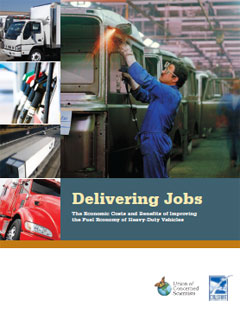Medium- and heavy-duty trucks account for only 4 percent of all vehicles on U.S. highways. Yet these trucks consume more than 20 percent of the diesel and gasoline used to power all vehicles on the nation’s roads—or more than 37 billion gallons of fuel. (1)
Unlike the fuel economy of cars and light trucks, the federal government has never regulated the fuel economy of medium- and heavy-duty vehicles. As a result of those missing standards and other market failures, these vehicles currently average about 6 miles per gallon, and have made only modest gains in fuel economy over the past 30 years. (2) That means this segment of vehicles represents a huge untapped resource for saving fuel.
In its recent Climate 2030 report, the Union of Concerned Scientists (UCS) found that widespread adoption of existing and near-term efficiency technologies could boost the average fuel economy of medium- and heavyduty trucks to 9.7 mpg by 2030. (3) What’s more, by investing in those technologies, the United States could save a total of 100 billion gallons of diesel and gasoline from 2010 to 2030, with annual savings reaching 11 billion gallons in 2030.
To investigate the economic impact of improving the efficiency of medium- and heavy-duty trucks, UCS collaborated with CALSTART, a consortium that focuses on clean transportation technology, and MRG & Associates, a resource analysis and planning firm. Building on results from Climate 2030, these analysts evaluated the effects of investments in advanced truck technologies on jobs across the nation, gross domestic product, and truck owners themselves.
These analyses show that the economic benefits of investing in advanced fuel-efficiency technologies far outweigh their costs. In fact, making trucks more fuel-efficient could save their owners money at the pump, create tens of thousands of jobs across the economy, reduce the nation’s dependence on petroleum, and help combat climate change.
Jobs and economic growth
- Widespread deployment of more-efficient trucks would create 63,000 additional jobs by 2020, and 124,000 jobs by 2030. All states would see net job growth. California, Texas, Florida, New York, Ohio, Illinois, Pennsylvania, Indiana, and Michigan would lead the way, with each adding more than 4,000 jobs by 2030 (UCS and MRG & Associates).
- Fuel and cost savings from advanced trucks would spur a $4 billion increase in annual gross domestic product by 2020 and $10 billion increase by 2030 (UCS and MRG & Associates).
Savings for truck owners
- Owners of advanced heavy-duty tractor-trailers could save $120,000 or more per truck over eight years, after paying back their initial $62,000-per-truck investment. Owners of large fleets of package delivery trucks or long-haul tractor-trailers could save hundreds of millions of dollars over 8 to 12 years (4) (CALSTART).
- By investing $4.7 billion by 2020 and $13.5 billion by 2030 in moreefficient trucks, the nation would reap savings of $10 billion by 2020 and $24 billion by 2030—over and above the initial costs of the technology (5) (UCS Climate 2030).
Energy security and climate benefit
- Investments in efficient medium- and heavy-duty trucks could save a total of 100 billion gallons of diesel and gasoline from 2010 to 2030. Annual fuel savings in 2030 alone could top 11 billion gallons (UCS Climate 2030).
- Those fuel savings would reduce global warming emissions by a total of 140 million metric tons in 2030—the equivalent of removing 21 million of today’s cars and trucks from the road (UCS Climate 2030).
However, our analyses also show that despite the cost-effectiveness of truck fuel-efficiency technologies and the benefits these technologies provide to the nation in the form of jobs and economic growth, market barriers have prevented (and will continue to prevent) their widespread adoption. These barriers include the common industry practice of considering only short-term fuel savings—often over the first two years or less—and uncertainty regarding the future price of fuel. Newer technologies face additional challenges, including high incremental costs and lack of good information on technology performance, reliability, and resale value.
These findings suggest that the nation needs strong, smart, and consistent policies to overcome market barriers and realize the powerful economic and environmental benefits of advanced truck technologies. Such a package would include performance standards for trucks as well as incentives that spur the industry to speed the development, production, and use of cost effective fuel-efficiency technologies.
- Federal Highway Administration, Statistics 2008, table VM1.
- Average on-road fuel economy of medium- and heavy-duty trucks fluctuated between 5.3 and 6.6 mpg from 1970 to 2007 (DOE 2009, tables 5-1 and 5-2).
- Cleetus, Clemmer, and Friedman 2009.
- This analysis assumes that diesel fuel costs $3.50 in real terms.
- This analysis assumes that diesel fuel costs $3.47 in 2020 and $3.40 in 2030.




